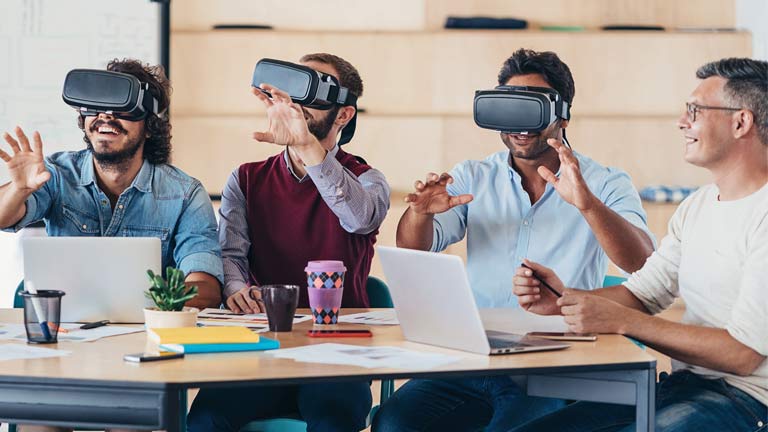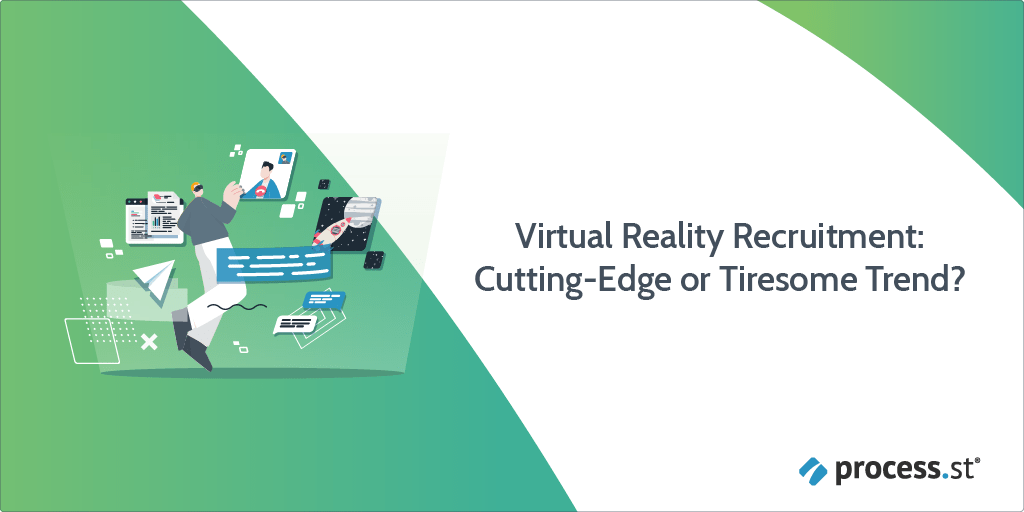Virtual Reality Recruitment: Cutting-Edge or Tiresome Trend?
Blog: The Process Street Blog

Virtual reality in recruitment is a growing trend in the recruiting world, thanks to the many benefits it offers. This is especially relevant for employer branding because virtual reality offers an immersive experience that allows candidates to engage with your brand directly.
Imagine candidates many miles away from you being able to put on a headset, and get an office tour! VR has many promising advantages for remote and hybrid hiring.
Stick here to learn more about how you can use VR in recruitment and whether VR is really the future of recruiting.
We’ll be covering:
- What does virtual reality in recruitment look like?
- 8 ways VR can be used in recruitment
- Benefits of using VR in recruitment
- Is VR the future of recruiting?
What does virtual reality in recruitment look like?
Recruitment can utilize virtual reality to give candidates an in-depth experience of what it would be like to work for or join an organization.
By “stepping into” VR experiences, applicants near and far can engage in your hiring process. This is especially promising for remote/hybrid hiring!
The three key ways that virtual reality is used in recruitment are:
- Communication/collaboration;
- Training/work simulations;
- Talent attraction/employer branding.
Let’s dive into each of these possibilities!
8 ways VR can be used in recruitment
Thanks to the many benefits VR offers in recruitment, companies can use it to:
1. Attracting top talent
Hiring managers can use VR to attract top talent (especially the younger workforce).
Younger people tend to look for engagement through technology when searching for jobs. Recruiters can, therefore, target them using VR.
Gen Z, in particular, is especially drawn to new tech and is growing up with tech like VR increasingly integrated into their daily lives.
So, regardless of which VR method you choose to use, adding a VR element to your hiring process may help with talent attraction.
2. Hiring & managing remote/hybrid workers
VR can be used to hire remote workers. It can also be very useful to manage them after hiring.
Since dealing with people working from different locations can be challenging, business leaders are aggressively looking for creative ways – including VR – to make communication and interaction among remote teams seamless.
Business Insider reported on how well-known companies Hyundai and Accenture have used VR to communicate within global teams; Hyundai designers have used VR to collaborate on projects.
Accenture built “Igloos” (pods) in which employees can step in and interact with each other from different locations as if they were in the same meeting room. These two examples show the potential for better collaboration and communication for remote and hybrid teams.
Remote and hybrid working systems have changed how communication and in-person meetings take place within a company. With VR, Workers can fully participate in meetings and interact with other employees. This helps create a more cohesive work environment and company culture, whether an employee is in person or remote.
Although VR in recruiting can offer several benefits to companies with remote and hybrid workers, companies that have the opportunity to adopt other impactful and easy-to-implement interviewing methods should not make it a priority.
It’s important to first lay the groundwork for good communication/collaboration practices before advancing to virtual reality methods. VR can be successfully implemented with other remote/hybrid work best practices.
3. Showcasing their brand
Companies can showcase their brand and what it’s like to work at their company with VR. For example, by giving potential employees a virtual tour of their offices.
This is particularly useful for remote and hybrid workers, as it gives them a glimpse of the company’s culture. This can help candidates feel more familiar and connected to your brand.
Familiarizing candidates with your brand is essential since some may want to know how things run in the company before even applying for a job position. Others also want to understand the company’s culture, which is possible using these tours.
This video from Tieto shows how candidates can learn about your brand by clicking their way around to navigate and interacting with people/areas within your virtual office.
For hybrid companies, showcasing your office space in a virtual tour can help show off different amenities/highlights of your office space, increasing your candidates’ interest in your company.
Beyond getting an office tour, VR can also show candidates what it’s like to work in a specific role. Deutsche Banne has had great success in using VR for hard-to-fill roles by letting candidates experience what it is like to work as a train conductor or electrician.
4. Interviewing candidates
One emerging benefit of VR is the possibility to interview remote candidates. While this is currently an emerging benefit, as VR tech adoption becomes more widespread, interviewing candidates with VR will become more and more accessible!
VR interviews can eliminate geographical barriers, allowing candidates from different regions or countries can be interviewed without a hitch. VR also offers several benefits when interviewing a candidate when compared to a regular video interview.
For example, you can more easily read their body language and create a better connection with candidates.
New tech will also allow candidates to practice interviewing with an avatar! Perhaps a bonus benefit for candidates will be being able to wear something comfortable to an interview, while their avatar is dressed up.
5. Assessing candidates
VR makes it easy and convenient to assess candidates. For example, you can assess a potential candidate by giving them a scenario and asking them what they can do to resolve it. This can also help “gamify” your hiring process.
Additionally, you can assess a candidate’s skills for practical jobs by asking them to complete a particular task. For example, if you want to test the coding skills of a software engineer, you can create a virtual setup and request them to do a task such as testing a code.
By assessing applicants, you can determine whether they are a good fit for a particular role or not. Furthermore, skills-based hiring is a great way to eliminate bias from the hiring process.
6. Employee training
You may want to equip your employees with some skills before they start working for your brand. Additionally, you may want to train them before a particular event. This is possible using VR, especially when dealing with remote or hybrid workers.
Training virtually comes with several benefits. These include less training time and safety. For example, Verizon has implemented safety training with VR so that employees are prepared to make quick decisions in high-pressure situations.
Another benefit is saving money by avoiding costly mistakes. Instead, VR training allows employees to make mistakes in the metaverse instead of on the job.
Walmart was an early adopter of using VR for employee training. In 2018, the company announced that it would be sending 17,000 Occulus Go headsets to its’ employees.
The announcement cited the following benefit as a reason for trying VR training:
“Because the effect of VR training is like an experience in real life, associates have the freedom to make mistakes and learn by ‘doing’, all while in a safe environment.”
7. Communicating with candidates
Communication between leaders and employees is crucial in every organization. VR could make communication between recruiters and candidates easy.
You can create virtual rooms to make it easy for candidates to communicate with you. Through these rooms, they can learn different things, such as your current job openings, the company’s culture, and the hiring process.
Imagine how it would feel for a candidate to pop on their Occulus glasses and suddenly feel as if they are right in front of you!
8. Improving employer branding
Good employer branding can help talent acquisition and employee retention. It also helps reduce recruitment costs. According to Glassdoor, brands can reduce their cost of hiring by 50%, just by having a good employer’s brand.
Using VR can send a message about your employer branding, for example, KFC created a VR training program that was essentially an escape room, where Colonel Sanders guides you through the five-step process of making their signature fried chicken recipe.
A KFC spokesperson explained to EATER that the VR is:
“… intended to be a fun way to celebrate the work KFC’s more than 19,000 cooks do every day in every restaurant across the U.S. in an engaging way.”
Companies can improve employer branding using VR since it showcases their innovative positioning. Additionally, companies with a strong culture can flaunt it to candidates, sparking their interest in working for them.
Benefits of using VR in recruitment

Based on the different applications for VR in recruitment, here are some of the benefits of implementing these practices:
Eliminates geographical barriers
HR managers get the opportunity to interview and assess many candidates – even those located far away – using VR. This eliminates geographical barriers, encouraging people from different regions to apply for job positions.
Eliminating geographical barriers increases gives brands more opportunity to hire top talent.
Makes recruitment faster
Recruiters can screen several candidates within a short time frame, which saves time.
By using VR assessments early on in the process, candidates whose skills are aligned with the position can be shortlisted. This is especially possible when there are tools such as automated applications and templates.
Eliminates conscious and unconscious bias
VR helps eliminate conscious and unconscious bias during recruitment.
For example, Accenture added VR to the early stages of the hiring process so that candidate skills can be assessed earlier on to reveal the true potential of all candidates before human bias can step in.
VR can also make your process more inclusive by allowing candidates to interview from anywhere, rather than limiting your reach to only those who can make the trek to your office.
Saves money
VR helps recruiters save money during the hiring process. It is less costly to conduct online than in-person interviews because employers don’t need to pay for hotel accommodations, travel costs, etc.
You can also assure through VR assessments that you are hiring candidates whose skills meet the job requirements, ensuring a better candidate fit. This saves money in the long run.
Gives a competitive advantage
When you use VR in recruitment, candidates will see that your company is innovative and progressive.
This gives you an upper hand over competitors who continue to recruit traditionally, especially when recruiting for Gen Z.
Improves candidates’ experience
Candidates will get the chance to directly engage with your brand. This does wonders for improving your candidate experience. Some candidates even prefer virtual interviews over face-to-face interviews.
Candidate experience is also improved since they don’t have to travel to attend interviews and assessments.
Is VR the future of recruiting?
With the increase in computer advancement, better internet speed, and increased digital knowledge, I believe virtual reality will soon play an essential role in day-to-day life in the future, including conducting recruitment.
In fact, younger generations will likely live each day in a cross-reality experience where much of their life is spent in different VR environments for work, school, socialization, and more! The possibilities for VR in recruitment and hiring are emerging as the tech improves and adoption grows.
VR is expected to deepen and improve the existing recruitment processes and create new ones. According to Statista, the size of the global VR market is expected to rise from less than $5 billion in 2021 to over $12 billion by 2024.
Although the use of VR is still in its infancy stage, it is constantly evolving and is already showing a bright future. The video Work in the Metaverse by Meta gives one take on what the future of work with VR being widely adopted could look like!
As the possibilities within VR grow, the way it can be used for attracting and retaining talent will also evolve.
Virtual Reality Recruitment: Final thoughts
VR is a promising new solution for beating your competitors when it comes to attracting talent and engaging candidates with your brand. This is especially relevant in today’s shift towards remote and hybrid work environments as VR lets candidates near and far experience your employer brand without leaving their house.
The caveat to this is that VR should accompany other recruitment/hiring best practices to ensure that your brand makes the most of this tech.
But as VR continues to grow in popularity, someday soon, we might all have our next job interview in the metaverse.
What do you think? Is VR the future of recruitment, or just a passing trend? Let us know in the comments below!

Rebecca Anderson is Recruitee’s US Content Marketer. Her goal is to educate and entertain HR and recruitment professionals with content on the latest topics disrupting the industry.
The post Blog first appeared on Process Street | Checklist, Workflow and SOP Software.
Leave a Comment
You must be logged in to post a comment.








